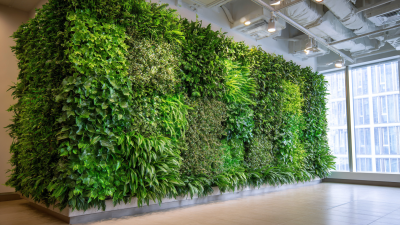As urban landscapes evolve, the integration of nature into built environments has become a vital consideration for modern businesses, leading to a surge in the popularity of Artificial Green Wall Panels. According to a report from MarketsandMarkets, the green wall industry is projected to grow from USD 1.1 billion in 2020 to USD 2.3 billion by 2025, reflecting a compound annual growth rate (CAGR) of 15.8%. These innovative installations not only enhance aesthetic appeal but also significantly improve air quality and thermal insulation. However, companies face challenges such as installation costs, maintenance, and sustainability concerns when adopting these green solutions. This ultimate guide aims to delve into the obstacles presented by Artificial Green Wall Panels while offering insightful solutions that help businesses successfully navigate these challenges and harness the full potential of greenery in their spaces.

Artificial green wall panels are gaining popularity in modern businesses as a sustainable solution for enhancing aesthetic and environmental value. However, their installation comes with a set of challenges that can impede their effectiveness and adoption. One of the most common challenges is the selection of appropriate plants. Factors such as sunlight exposure, water requirements, and cold tolerance must be carefully considered to ensure the longevity and health of the green wall. A tailored approach to plant selection not only ensures vibrant growth but also enhances carbon sequestration, contributing positively to urban sustainability efforts.
Another challenge lies in the maintenance of these installations. Regular upkeep is essential for preserving the visual appeal and ecological benefits of artificial green walls. Businesses often struggle to allocate resources for this continuous maintenance, which can lead to deterioration of the wall's integrity. Implementing a comprehensive maintenance plan that outlines appropriate care practices can mitigate these issues, allowing businesses to fully leverage the advantages of artificial green walls while contributing to a greener and healthier urban environment.
| Challenge | Description | Possible Solutions | Impact on Business |
|---|---|---|---|
| Installation Complexity | Difficulty in correctly fitting panels based on wall dimensions and structural integrity. | Engage experienced installers and provide detailed measurement guides. | Delay in project timelines leading to increased costs. |
| Maintenance Requirements | Artificial green walls require regular cleaning and upkeep to maintain appearance. | Develop a maintenance schedule and hire professional cleaning services. | Potential for decreased visual appeal, impacting customer perception. |
| Cost of Installation | High initial investment can deter businesses from adopting green walls. | Assess ROI through energy savings and increased foot traffic. | Increased upfront costs may limit budget allocation for other improvements. |
| Environmental Impact | Concerns about the sustainability of materials used for artificial walls. | Choose eco-friendly materials and promote their benefits to stakeholders. | Negative publicity resulting from unsustainable practices. |
| Aesthetic Limitations | Limited options in terms of design and plant varietals. | Explore customization options and incorporate a variety of textures. | May decrease appeal to investors and customers seeking unique designs. |
In recent years, artificial green wall panels have emerged as a popular solution for businesses seeking to enhance aesthetics and improve indoor air quality. However, the challenges of durability and maintenance can impede their widespread adoption. According to a report by the International Society of Horticultural Science, properly designed artificial green walls can improve air quality by up to 30%, but the longevity of these installations frequently relies on their maintenance protocols. This highlights the necessity for innovative solutions that not only maximize the visual impact but also ensure sustained functionality.
To enhance the durability of artificial green wall panels, businesses should consider using high-quality, UV-resistant materials that can withstand environmental stresses. Regular maintenance is crucial; implementing an automated irrigation system can reduce the need for manual watering while ensuring that plants receive the right amount of moisture. According to a study from the Green Roofs for Healthy Cities organization, well-maintained green walls can last over 15 years, providing long-term benefits to businesses.
Tips for maintenance include scheduling biannual check-ups to inspect for pests and diseases, and incorporating a thorough cleaning routine to remove dust and debris. Additionally, selecting a diverse range of plant species can improve resilience against potential diseases, as biodiversity can enhance overall health and reduce maintenance needs significantly. By investing in these strategies, businesses can enjoy the benefits of artificial green wall panels while overcoming common challenges associated with their upkeep.
The increasing popularity of artificial green wall panels in modern businesses has led to demands for cost-effective sourcing strategies. According to a recent industry report, the global vertical garden market is expected to reach $3.9 billion by 2025, driven by urbanization and a growing emphasis on sustainable practices. Businesses looking to adopt these eco-friendly design features must consider both quality and cost without compromising aesthetic appeal.

One effective strategy for sourcing quality green wall panels is to partner with reputable manufacturers who prioritize sustainability. Reports indicate that choosing suppliers who use recycled materials can reduce costs by up to 20%, while simultaneously promoting environmentally responsible practices. Additionally, bulk purchasing agreements often yield significant discounts, enabling businesses to invest in high-quality panels that align with their eco-conscious values. By leveraging these cost-effective sourcing strategies, companies can enhance their workspaces while also contributing to a greener economy.
Integrating sustainability practices with artificial green walls presents a transformative opportunity for modern businesses to enhance their environmental responsibility while benefiting from the aesthetic appeal and health advantages of greenery. These innovative wall systems not only simulate the beauty of natural plants but also require significantly less water and maintenance, making them an ideal choice for businesses aiming to decrease their ecological footprint. By choosing artificial options, companies can create visually striking spaces devoid of the drawbacks associated with live plants, such as pests and seasonal variations.
Furthermore, the implementation of artificial green walls can be aligned with broader sustainability initiatives, such as carbon offsetting and energy efficiency. With advancements in technology, these panels can incorporate features like solar panels and air purification systems, contributing to a healthier indoor environment. Businesses can showcase their commitment to sustainability by investing in these systems, improving employee well-being, and attracting environmentally-conscious customers. This dual benefit makes artificial green walls an appealing solution for organizations looking to merge aesthetics, functionality, and ecological impact seamlessly.
In the quest to enhance aesthetic appeal, modern businesses are increasingly turning to artificial green wall panels as a sustainable design solution. According to a recent report by Grand View Research, the global vertical garden market is projected to reach $3.2 billion by 2025, driven by a growing consumer preference for eco-friendly designs. With advancements in materials technology, artificial green wall panels mimic the beauty of natural plants without the associated maintenance costs, making them an attractive option for businesses seeking to create an inviting environment.
To maximize the impact of these green installations, strategic design choices are essential. For instance, a study published in the Journal of Environmental Psychology highlights that green spaces can improve mood and productivity, suggesting that integrating vibrant plant designs into commercial spaces can enhance customer experience. Businesses should consider factors such as color schemes and plant placement to create dynamic visual interest while aligning with their brand identity. By adopting these design strategies, businesses can significantly increase their aesthetic appeal and promote a sustainable image in today's competitive marketplace.













